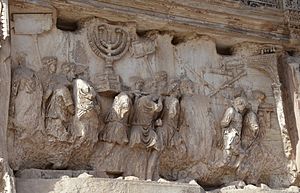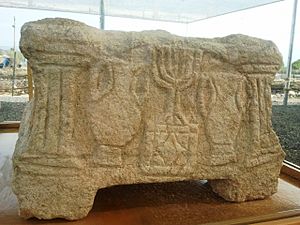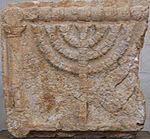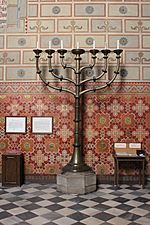Temple menorah facts for kids
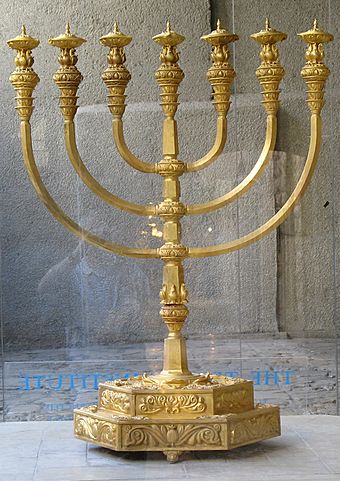
The menorah (pronounced meh-NOH-rah) is a special lampstand with seven branches. It is described in the Hebrew Bible as being used in the Tabernacle (a portable temple) and later in the Temple in Jerusalem. For a very long time, the menorah has been a symbol for the Jewish people and their religion, Judaism. It is important both in Israel and for Jewish people living all over the world. When the State of Israel was created in 1948, the menorah became its official symbol.
The Hebrew Bible says the menorah was made from pure gold. It was lit using only fresh olive oil. The menorah was first kept in the Tabernacle. Later, Solomon's Temple had ten menorahs. These were taken away by the Babylonians. The Second Temple also had a menorah. After the Romans destroyed Jerusalem and the Temple in 70 CE, they took the menorah to Rome. The famous Arch of Titus in Rome still shows Roman soldiers carrying the menorah away. Later, in 455 CE, the Vandals reportedly took the menorah to Carthage after attacking Rome. A historian named Procopius said the Byzantine army found it in 533 CE and brought it to Constantinople. He also said it was later sent back to Jerusalem. However, no one knows for sure where it is today.
The menorah is often seen in Jewish art. We don't have pictures of it from the time of the First Temple. But some images from the Second Temple period have been found. These include pictures on coins and walls in Jerusalem, and on objects like the Magdala stone. After the Second Temple was destroyed, the menorah became a clear Jewish symbol. It appeared on tomb walls, synagogue floors, sculptures, and glass and metal objects. It helped tell Jewish places apart from Christian and pagan ones. The menorah symbol has also been found in old items from Samaritan, Christian, and Islamic groups. The Hanukkah menorah, which has nine branches, is a special version used during the Jewish holiday of Hanukkah.
Contents
How the Menorah Was Made
Bible's Description
The Hebrew Bible says that God showed Moses how to design the menorah. Here is how the Bible describes its creation:
- Make a lampstand from pure gold.
- Hammer out its base and main shaft.
- It should have flower-like cups, buds, and blossoms, all made from one piece of gold.
- Six branches will come out from the sides of the lampstand, three on each side.
- Each of these six branches will have three cups shaped like almond flowers with buds and blossoms.
- The main lampstand shaft will have four cups shaped like almond flowers with buds and blossoms.
- A bud should be under each of the three pairs of branches.
- All the buds and branches must be one piece with the lampstand, hammered from pure gold.
- Then, make its seven lamps and set them up to light the area in front.
- Its tools for trimming wicks and trays must also be pure gold.
- A large amount of pure gold (a talent) should be used for the lampstand and all its parts.
- Make sure to build it exactly as shown to Moses on the mountain.
The Book of Numbers (Chapter 8) adds that the seven lamps were meant to give light in front of the lampstand. It repeats that it was made just as God showed Moses.
Other Ancient Descriptions
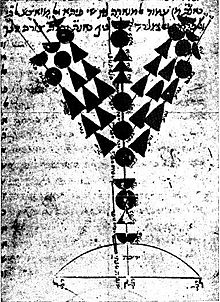
Jewish teachers say the menorah was about 1.62 metres (5.3 ft) tall. It stood in the front room of the Temple. Some ancient scholars disagreed on its exact position. The branches are often shown as curved. However, some important Jewish thinkers, like Rashi and Maimonides, believed they were straight. Other Jewish experts from ancient and medieval times thought the arms were round.
Josephus, a Jewish historian who saw the Temple destroyed, said the menorah was placed at an angle, towards the east and south.
Arch of Titus in Rome
The most famous image of the Second Temple's menorah is on the Arch of Titus in Rome. This arch celebrates the Roman victory after they destroyed Jerusalem in 70 CE. The carving on the arch shows the menorah on a base with six sides. This base looks like steps. Each side of the base has designs carved into it.
Magdala Stone
In 2009, the remains of a synagogue in Magdala were found. Pottery from before the Temple's destruction was also there. Inside the synagogue, a carved stone block was found. It had a picture of the seven-lamp menorah. This menorah looks very different from the one on the Arch of Titus. It might have been carved by someone who actually saw the menorah in the Temple. This menorah has straight, not rounded, arms. Its base is triangular, not stepped. This stone was found far from Jerusalem. The Arch of Titus is often seen as a direct view of the menorah being taken from the Temple.
How the Menorah Was Used
According to the Book of Exodus, the menorah's lamps were lit every day. They used fresh, special olive oil and burned from evening until morning.
Josephus said that three of the seven lamps also burned during the day. However, some Jewish texts say only the center lamp stayed lit all day. This center lamp was filled with as much oil as the others. Even though it was lit first, it kept burning while the others went out. This was seen as a miracle, a sign that God's presence was with Israel. It was called the ner hama'aravi (Western lamp). It was also called the ner Elohim (lamp of God). The Talmud says this miracle stopped after the time of Simon the Just (3rd or 4th century BC).
Unlike some modern designs, the ancient menorah burned oil. It did not use candles, which were not common in the Middle East until around 400 CE.
Menorah's Journey Through History
In the Tabernacle
The first menorah was made for the tabernacle, a special tent used for worship. The Bible says it was there until the Israelites crossed the Jordan River. When the tabernacle was set up in Shiloh, the menorah was likely there too. But it is not mentioned when the Ark of the Covenant was moved during the time of Samuel and Saul.
In Solomon's Temple
According to the Books of Kings and Books of Chronicles, Solomon made ten lampstands (menorahs). These were placed in the main room of Solomon's Temple. The weight of these lampstands was part of the detailed instructions given to Solomon by David. The Book of Jeremiah says that the Babylonian general Nebuzaradan took these lampstands after Jerusalem was destroyed.
In the Second Temple
When the Second Temple was built after the Jewish people returned to Israel, there is no mention of the menorah being returned. Only "vessels" are mentioned. The Book of Maccabees says that Antiochus IV took away the lampstands when he robbed the Temple. Later, new holy vessels were made, which might have included new lampstands.
Journey to Rome
The menorah from the Second Temple was taken to Rome after Jerusalem was destroyed in 70 CE during the First Jewish–Roman War. The historian Josephus says it was brought to Rome and carried in the victory parade of Vespasian and Titus. The carving on the Arch of Titus in Rome shows Roman soldiers carrying the menorah and other treasures from the Temple.
For many years, the menorah and other Temple treasures were shown as war trophies in Rome. They were still there when the city was attacked by the Vandals in 455 CE.
After the Vandals Attacked Rome
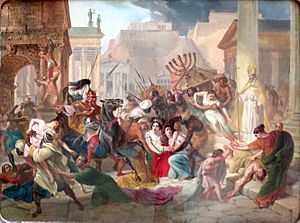
The Vandals took the Menorah and other treasures from the Temple in Jerusalem when they attacked Rome in 455 CE. They carried them to Carthage, the capital of their kingdom. The treasures were still there in 533 CE when a Byzantine army led by General Belisarius captured Carthage. Belisarius took the Menorah and other treasures to Constantinople as war trophies. Procopius, a historian, says the Menorah was carried through the streets of Constantinople in Belisarius's victory parade. Procopius also says that the emperor Justinian, worried that the treasures brought bad luck, sent them back to Jerusalem. However, there is no record of them arriving there. If the Menorah did reach Jerusalem, it might have been destroyed when the city was attacked by the Persians in 614 CE.
Many stories and ideas exist about what happened to the Menorah. Some think it was melted down for gold, destroyed in a fire, kept in Constantinople, or lost in a shipwreck. A common rumor is that the Vatican has kept it hidden for centuries. Some say it is in Vatican City, others that it is in the cellars of a church called the Archbasilica of St. John Lateran.
In a Jewish text called Avot of Rabbi Natan, it lists Jewish treasures that are believed to still be in Rome. This text says: The spice-grinder, the golden table, the menorah, the curtain, and the head-plate are still sitting in Rome.
What the Menorah Symbolizes
In Judaism
The menorah stands for the idea of spreading light and understanding to everyone. It also symbolizes wisdom. The seven lamps represent different areas of human knowledge. The six outer lamps lean towards the central lamp, which represents the light of God. This shows that God's light guides all knowledge. The menorah also reminds us of the seven days of creation, with the center light representing the Sabbath (day of rest).
Hanukkah Menorah
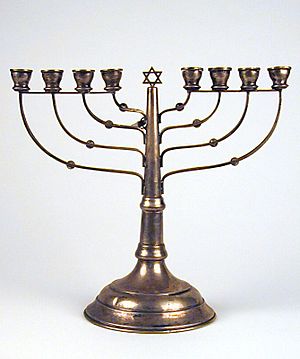
A menorah with nine branches is a very important symbol for the Jewish holiday of Hanukkah. The story of Hanukkah tells that after the Seleucid army damaged the Jewish Temple in Jerusalem, there was only enough special olive oil to light the eternal flame for one day. But, a miracle happened, and the oil burned for eight days! This was enough time to make new pure oil.
Jewish law says it is not allowed to use a seven-lamp menorah outside of the Temple. So, a Hanukkah menorah has eight main branches, plus a ninth lamp that is set apart. This ninth lamp is called the shamash (servant) light. It is used to light the other eight lamps. This type of menorah is called a hanukkiah in Modern Hebrew.
In Christianity
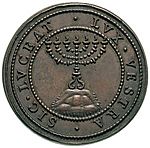
In the Christian Book of Revelation, seven golden lampstands are mentioned. They represent seven churches. The messages to these churches from Jesus Christ are thought to apply to churches of all times. They also show different periods of church history and offer personal lessons for believers.
Some early Christian thinkers, like Clement of Alexandria, believed the seven lamps of the golden menorah represented the seven classical planets: the Moon, Mercury, Venus, the Sun, Mars, Jupiter, and Saturn.
It is also said to symbolize the burning bush that Moses saw on Mount Horeb.
In the Eastern Orthodox Church, menorahs are still used. They are always placed on or behind the altar in the church. While candles can be used, it is traditional to use olive oil in the seven-lamp stand. Usually, all seven lamps are lit for services. Sometimes, only the three center lamps are lit for smaller services. If a church does not have a special sanctuary lamp, the center lamp of the menorah might stay lit as an eternal flame.
Menorah in Art
Jewish Art
Using the Temple menorah as an art decoration was rare during the Second Temple period and up to the Bar Kokhba revolt. Examples were found in burial caves near Mukhmas, in Jerusalem, and in Magdala (on the Magdala Stone). The menorah became much more common in Jewish art, especially in art on tombs, during the late Roman and Byzantine periods.
Samaritan Art
Samaritan stone lamps were an important part of Samaritan synagogues during the Byzantine period.
Modern Jewish Uses
In Synagogues
Synagogues have a lamp or light that is always lit in front of the Torah ark. This is where the Torah scroll is kept. It is called the ner tamid (eternal light). This lamp represents the ner Elohim of the menorah that was used in Temple times. Many synagogues also display a menorah or a picture of one.
State of Israel Symbol
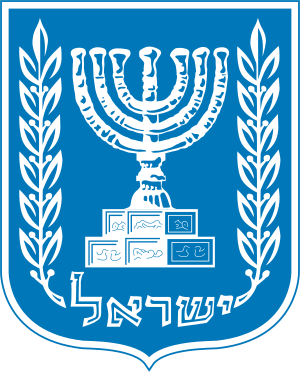
A menorah is part of the Emblem of Israel. This design is based on the menorah shown on the Arch of Titus.
Temple Institute's Reconstruction
The Temple Institute has built a life-sized menorah. It was designed by a goldsmith named Chaim Odem. This menorah is meant to be used in a future Third Temple. The Jerusalem Post newspaper described it as being made "according to very exact Bible rules." It is ready to be used if needed. The menorah is made from a large amount of pure 24-karat gold (about 45 kg). It was hammered from a single block of solid gold. Its decorations are based on the menorah shown on the Arch of Titus and the Temple Institute's understanding of religious texts.
Other Modern Jewish Uses
A menorah was on the cap badge of the First Judeans of the Jewish Legion (1919–1921).
Sometimes, when teaching the Hebrew language, a chart shaped like the seven-lamp menorah is used. It helps students remember how Hebrew verbs are formed.
The menorah is a main part of several Holocaust memorials.
-
The Knesset Menorah outside the Knesset (Israeli Parliament).
-
The Jewish Legion cap badge: menorah and the word Kadima (forward).
-
Menorah memorial from the State of Israel with wreaths at the KZ Mauthausen memorial, Austria.
Similar Objects
The kinara is a seven-candle holder. It is like the menorah and is used in the African American festival of Kwanzaa. One candle is lit each day of the week-long celebration, similar to the Hanukkah menorah.
In Taoism, the Seven-Star Lamp qi xing deng is a seven-lamp oil lamp. It represents the seven stars of the Northern Dipper. This lampstand must be in all Taoist temples and never go out. During a festival in the 9th lunar month, a lamp with nine connected lamps may be lit. This honors the Northern Dipper and two other stars. The lamps represent the light of the stars. Lighting them is believed to help forgive sins and make one's life longer.
Images for kids
-
Second Temple period stone tablet from a synagogue in Peki'in, Israel.
-
Drawing from a prayer book showing the lighting of the Menorah, 1738, from the collections of the National Library of Israel.
-
In this 1806 French print, the woman with the menorah represents the Jews being freed by Napoleon Bonaparte.
-
Kippa and menorah from the Harry S Truman collection.
-
The menorah given to Tsar Boris III from the Bulgarian Jewish community (Tsarska Bistritsa).
-
A menorah on the flag of Iglesia ni Cristo.
-
Fray Juan Ricci (1600–1681), sketch of the menorah as described in Exodus, undated.
See also
 In Spanish: Menorá para niños
In Spanish: Menorá para niños
- Star of David
- Emblem of Israel
- Jewish symbols
- Drabsha, a symbol of the Mandaean faith that represents the Light of God and seven days of creation.
- Mishneh Torah Avodah Laws of the Temple 3:1–10
- Seven-branched candelabrum (Essen)


